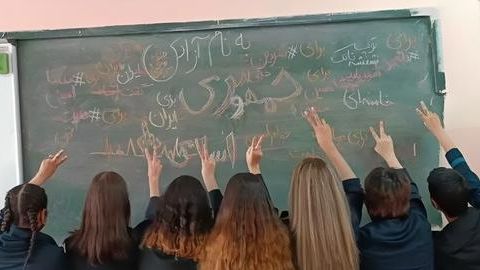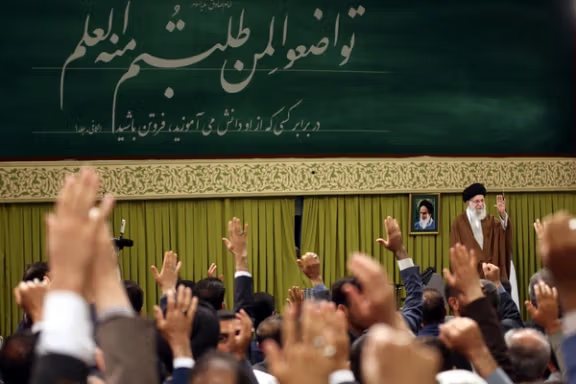Khamenei’s Failed Legacy: Iran’s Youth Reject Political Islam

On Teacher's Day, the Supreme Leader of the Islamic Republic often boasts that teachers "are the architects of Iran's future."

On Teacher's Day, the Supreme Leader of the Islamic Republic often boasts that teachers "are the architects of Iran's future."
In Ali Khamenei's myopic worldview, this future likely entails today's young Iranians carrying on the torch of the 1979 Islamic Revolution, along with its tenets of political Islam.
But, the ruler's decades-long endeavor to indoctrinate and shape post-revolution generations of Iranians through the education system and dozens of state and religious propaganda outfits has failed, tarnishing the legacy of the Islamic Republic.
From widespread secularization to the populace's resolute anti-regime stance and protests, Iran has witnessed profound transitions over the past decade. In the process, it's evident that the people have turned their backs to the aspirations of both Supreme Leaders.
Today's youth, thoroughly detached from the state, often lead dual lives: experiencing pervasive oppression at schools and universities while encountering contrasting narratives of pre-revolutionary life at home. Despite crackdowns on internet access amid protests, Generation Z has found a window into life in the West, solidifying their rejection of their daily reality.
But, Khamenei can’t take all the credit for this rejection – after all, he is only the second Supreme Leader. His predecessor, Ruhollah Khomeini, did his share to try and forcibly imprint his worldview onto Iranian youth through school curriculums.

Khamenei, though, is unlikely to cease his efforts. Recently, the regime's education officials have hinted at several overhauls, indicating a further tightening of control over what is taught to children and students.
Here is a brief overview of what you need to know about the Islamic Republic’s quest to mold the future Iranian generations through schools and universities – and how they failed in their goal to establish Iran as a successful example of political Islam.
Islamic ‘Revolutionary’ Overhaul of Iran's Education System
Let’s take a step back.
For a period after the revolution in 1979, after the ouster of Iran’s monarch Shah Mohammad Reza Pahlavi, Iranian universities were shut down to completely alter the country’s education system according to the new government's ideological framework.
“Iran's new revolutionary authorities are engaged in a massive upheaval of the country's educational system from the primary grades through the universities,” reads a Washington Post article from 1980.
Literature textbooks would start with songs and slogans of the Islamic revolution – and instead of reading the great Persian poets, young children would learn chants like “Khomeini, Khomeini, you are light from God” and "This American shah should be executed."
In directives that could be called revisionism, history textbooks were rewritten to promote Islamic principles and so-called revolutionary values, with hardly any mention of the ancient kings of Persia.
The Islamic Republic’s first Supreme Leader Rouhollah Khomeini early on saw the potential in using the education system to pass on the ideals articulated with the birth of Islam 14 centuries ago.
Conversely, Shah Mohammad Reza Pahlavi’s “White Revolution” in the 60s and 70s had aimed to modernize Iran through means that included educational advances – including the deployment of teachers to villages that had no schools. The educational system was secular and mostly based on the European models, although students had a weekly hour about the White Revolution and modernization.
Schools Under Siege by Radical Indoctrination and Political Islam
Several studies show that over the last decades, the Iranian school curriculum for Grades 1 - 12, has promoted radical ideological indoctrination.
“Gender discrimination permeates Iran's textbooks. Women are accorded little importance as individuals, and their contributions to society outside the home are largely ignored. This attitude toward women is justified in the textbooks through numerous references to the Koran and the lives of prophets and Imams,” an extensive Freedom House study by Saeed Paivandi reads.
Textbooks advocate for the destruction of Israel, glorify child martyrdom and jihad, while fostering animosity toward the US. School materials also venerate past Iranian empires and promote false narratives in history textbooks.
“Iran largely continues to educate students for the prospect of a global war, and the spreading of the Islamist-Khomeinist revolution. There is a greater focus on Iran’s desire to export its global Islamic Revolution to the Arab Middle East compared to past curricula, with students encouraged to engage in militant activity to achieve Iranian hegemony,” a study by IMPACT-se read, which evaluated Iranian school materials for UNESCO peace and tolerance criteria.
Today, the regime continues its agenda to forcibly imprint political Islam on Iran’s youth, as evident by the growing influence of clerics and mosques in Iran's educational system – particularly with the recruitment of clerics as teachers, the establishment of mosque-centered and seminary-affiliated schools.
In line with Khamenei's anti-Western stance, measures have included prohibiting primary students from studying English and removing the requirement for older students to learn English. Arabic, however, remains compulsory "as the language of the Qur'an" for first and second-year secondary students, as per education officials.
In a nod to the government’s close economic dependance and ties to Beijing, Iranian authorities are reportedly seriously discussing the possibility of adding Chinese to the foreign languages taught in the nation's schools.
In some universities, the flags of Israel and the US are painted at entrances, a regime tactic to force students to walk over them as a sign of disrespect. Yet, social media videos often show Iranian students carefully avoiding to walk on the flags – highlighting their resistance and the failure of Khamenei's policies.
Schools, Universities as Battlegrounds Against Regime
Since 1979, schools and universities have emerged as focal points of unrest and opposition to the regime.
From prominent activist Majid Tavakoli’s historic speech in 2009 on the steps of Amir-Kabir University on the Day of students, bravely and directly attacking Supreme Leader Khamenei, to Iranian schoolgirls in 2022 ripping out images of Khomeini and Khamenei from their textbooks, while chanting “Death to the dictator” – the youth has shown their opposition to the regime’s doctrine.
Following the most recent round of nationwide anti-regime protests in 2022 and 2023, security forces unleashed a fresh wave of crackdowns at universities – using both verbal and physical assault to suppress the student opposition movements.
Amid protests, tens of thousands were arrested – including at least hundreds of students, teachers and professors.
The state has kept up its pressure and tactics to target teachers who joined demonstrations, including arrests, threats, expulsions, and forced retirements.
Regime's Repression Targets Iranian Schoolgirls
Girls’ school particularly became a focal point for unrest after the killing of Mahsa Jina Amini in September 2022, while she was in the custody of the so-called morality police for a hijab violation.
Amid and following those protests, thousands of schoolgirls were reportedly poisoned – with human rights activists and Iranian journalists blaming the regime in Tehran for another “form of gender-based attacks in the country.” Activists also suggest that the wave of attacks were a reprisal for the students’ participation in nationwide protests.
Strengthening those arguments, are the fact that it took Khamenei three months to comment on the attacks and that no arrests have been made in connection with the reported poisonings.
Last year, IranWire exclusively reported that Iranian schoolgirls have been forced to watch pornographic videos at school, aimed at deterring them from joining anti-government protests.
These sessions, conducted by the regime’s security forces, used the explicit content to argue that the protesters' demands would lead to moral decay.
“A cleric accompanied by a woman wearing a hijab and men in uniforms and civilian clothes visited the school and gathered students in 10th, 11th and 12th grades in a classroom. The visitors forced them to watch videos with porn scenes, including rapes and sexual intercourses between humans and animals, in a bid to convince the children that the protesters’ demands would lead to sexual decadence in Iran,” the report read.
The incident caused significant distress among the students, with one student suffering a nervous breakdown and needing to be hospitalized for two days.
Universities at the Heart of Regime’s Foreign Policy Strategy
Universities in Iran have also played an integral role in the Islamic Republic’s foreign policy strategy – which includes recruiting foreign students as ideological ambassadors. These students, often from influential families, are trained to promote Iran’s agenda globally under the guise of "cultural secretaries."
Iran’s Al-Mustafa International University plays a key role in this strategy, receiving substantial funding to educate foreign students and spread the regime’s Shiism worldwide. The institution has students from China, African countries and Latin America. The university has faced international sanctions for allegedly recruiting combatants for conflicts like the war in Syria.
Tehran’s Sharif University for instance, is also under international financial sanctions and known for its close ties to the military and being engaged in military and ballistic missile-related projects for the Iranian government.
Iran's Teachers Confront Hostility and a Failing Educational System
While the Supreme Leader has verbally revered the role of teacher’s in the country, teachers themselves have been met with hostility by the regime.
Their jobs have been hampered by severely low salaries, poor working and living conditions – and in return, placated with unfulfilled promises.
Recently, teacher’s have warned that the regime’s brand of ideological curriculum means a “dead end” for children – and that the authorities have failed in the education sector.
Teachers report that students are rejecting the mandated school curriculum, which is heavily dominated by ideological and religious content, even within science subjects. They say this has led to a significant loss of interest among students.
The regime's security forces have also often attacked gatherings of parents voicing their concerns about the significant qualitative shortcomings of the country's educational system, including a shortage of staff.
Among its shortcoming, an expert report published last year by the ‘reformist’ news outlet Etemaad, showed several significant qualitative deficiencies in Iran's education system – including a lack of justice in providing educational opportunities and a legitimacy gap, stemming from disparities between students' expectations and authorities' ideological perspectives.